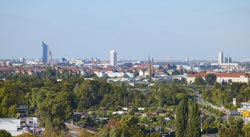Live fast, die young

Cities in both, the US and Europe harbour more plant species than rural areas. However, plant species of urban areas are closer related to each other and often share similar functions. Consequently, urban ecosystems should be more sensitive towards environmental impacts than rural ecosystems.
This is concluded by German and US scientists based on a field study in Minneapolis (Minnesota) led by Jeannine Cavender-Bares, Associate Professor at the University of Minnesota. The new study confirms results obtained by Dr. Sonja Knapp and colleagues of Helmholtz Centre for Environmental Research (UFZ) in a study on the German flora in 2008. The new results have been published as a preprint in ECOLOGY and have been highlighted in the renowned science magazine NATURE.
The recent study compared plant diversity in private yards of the Twin Cities metropolis Minneapolis-St. Paul in the Midwest of the United States with plant diversity at the nearby Cedar Creek Ecosystem Science Reserve, part of the Long-Term Ecological Research network supported by the U.S. National Science Foundation.
Cities are growing around the world, and understanding how urbanization and urban gardening impact biodiversity and ecosystem services is increasingly important. Scientists from the University of Minnesota, UFZ in Halle and Max-Planck Institute for Biogeochemistry in Jena, Germany, the University of California, and Whittier College California asked how different urban plant diversity in private yards is from the diversity of naturally occurring plants. Using a newly established global plant trait database (TRY), they found that the typical spontaneous yard species is short-lived, fast-growing, produces small seeds, uses humans as dispersal vectors, and is adapted to high temperatures.
The scientists point out that the promotion of self-pollinated species by the urban environment might result into cascading effects on pollinators: “If self-pollinating species are supported by urbanization and consequently increase their frequency in the regional species pool, fewer pollinators such as bees or butterflies will be supported” says Sonja Knapp. The scientists are also critical about invasive species that can be dispersed beyond yard boundaries. Still, cultivating more native plant species could have positive effects on the evolutionary diversity and potential of urban vegetation. „As yard plants spread into natural habitats, the ability of those ecosystems to respond to environmental change could be reduced”, summarizes NATURE in its current „Research Highlights”. “These results suggest that urbanites should consider gardening and harboring a higher number of native species,” says Cavender-Bares.
In the 2008-study on the German flora, Sonja Knapp and colleagues analysed 14 million entries on plant occurrences in the FLORKART-database, which have been acquired by thousands of experts and volunteers. In the face of changing environmental conditions, nature conservation should not only focus on the protection of a high number of species, but also on evolutionary diversity. As urbanization will continue to shape our planet, nature conservation strategies for urban biodiversity should be developed, stated the scientists in their 2008-article in Ecology Letters.
The loss of evolutionary information will reduce species‘ chances to adapt to environmental changes and might, on the long term, negatively impact urban ecosystems. This assumption has now been confirmed with the Minnesotan field study.
Tilo Arnhold
http://www.ufz.de/index.php?en=30376
Publication:
Knapp, S., Dinsmore, L., Fissore, C., Hobbie, S. E., Jakobsdottir, I., Kattge, J., King, J., Klotz, S., -McFadden, J. P. & Cavender-Bares, J. (2012): Phylogenetic and functional characteristics of household yard floras and their changes along an urbanization gradient. Ecology, in Press
http://dx.doi.org/10.1890/11-0392.1
A look at backyard biodiversity.
Nature 484, 144 (12 April 2012); doi:10.1038/484144b
http://dx.doi.org/10.1038/484144b
More scientific information:
Dr. Sonja Knapp
Helmholtz Centre for Environmental Research (UFZ)
Phone: +49 (0) 345-558-5308
http://www.ufz.de/index.php?en=7278
or
Tilo Arnhold (UFZ-press office)
Phone: +49 (0) 341-235-1269
E-mail: presse@ufz.de
Additional links:
Similarity of urban flora – New study shows that plants in towns and cities are more closely related than those in the countryside (Press release September, 18th 2008)
http://www.ufz.de/index.php?en=17194
At the Helmholtz Centre for Environmental Research (UFZ) scientists are researching the causes and consequences of far-reaching changes to the environment. They are concerned with water resources, biological diversity, the consequences of climate change and adaptability, environmental and biotechnologies, bioenergy, the behaviour of chemicals in the environment, their effect on health, modelling and social science issues. Their guiding theme: Our research contributes to the sustainable use of natural resources and helps to secure this basis for life over the long term under the effects of global change. The UFZ employs 1,000 people in Leipzig, Halle and Magdeburg. It is financed by the federal government and the federal states of Saxony and Saxony-Anhalt.
http://www.ufz.de/
The Helmholtz Association contributes towards solving major and pressing social, scientific and economic issues with scientific excellence in six research areas: Energy, Earth and Environment, Health, Key Technologies, Structure of Matter, Aeronautics, Aerospace and Transport. The Helmholtz Association is Germany's largest scientific organisation with over 33,000 employees in 17 research centres and an annual budget of approximately 3 billion euros. Its work stands in the tradition of the naturalist Hermann von Helmholtz (1821-1894).
http://www.helmholtz.de
Media Contact
All latest news from the category: Ecology, The Environment and Conservation
This complex theme deals primarily with interactions between organisms and the environmental factors that impact them, but to a greater extent between individual inanimate environmental factors.
innovations-report offers informative reports and articles on topics such as climate protection, landscape conservation, ecological systems, wildlife and nature parks and ecosystem efficiency and balance.
Newest articles

Security vulnerability in browser interface
… allows computer access via graphics card. Researchers at Graz University of Technology were successful with three different side-channel attacks on graphics cards via the WebGPU browser interface. The attacks…

A closer look at mechanochemistry
Ferdi Schüth and his team at the Max Planck Institut für Kohlenforschung in Mülheim/Germany have been studying the phenomena of mechanochemistry for several years. But what actually happens at the…

Severe Vulnerabilities Discovered in Software to Protect Internet Routing
A research team from the National Research Center for Applied Cybersecurity ATHENE led by Prof. Dr. Haya Schulmann has uncovered 18 vulnerabilities in crucial software components of Resource Public Key…





















